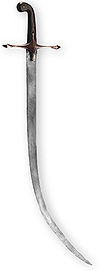- Shamshir
-
Shamshir 
Angaben Waffenart: Säbel Bezeichnungen: Shamshir, Shamsheer, Chimchir Verwendung: Waffe Ursprungsregion/
Urheber:Persien, Ethnien aus Persien Verbreitung: Persien Gesamtlänge: etwa 90 cm bis etwa 99 cm Klingenlänge: etwa 74 cm bis etwa 86 cm Griffstück: Metall, Elfenbein, Holz, Knochen, Jade Listen zum Thema Der Shamshir (engl. "Lion's Paw, dt. "Tatze des Löwen"), auch Shamsheer, Chimchir, ist ein Säbel aus Persien.
Inhaltsverzeichnis
Beschreibung
Der Shamshir hat eine gebogene, einschneidige Klinge. Die Klinge wird vom Heft zum Ort schmaler. Der Ort ist spitz gearbeitet. Das Heft hat ein kreuzförmiges Parier. Das Heft ist entweder mit Griffschalen aus verschiedenen Materialien belegt, oder besteht aus einem Stück. Der Knauf ist in der Regel abgebogen und kugelförmig gearbeitet. Die Scheiden bestehen meist aus Holz, das mit Metallblech oder Stoffen überzogen ist. Die Klingenkrümmung ist variabel. Es gibt leicht- bis stark gebogene Klingen, die fast eine halbmondförmige Krümmung haben. Es gibt Versionen mit glatter oder geflammter Klinge oder auch mit einem geteilten Ort, die dem Schwert Mohammeds nachempfunden wurden. Der Shamshir wurde in verschiedenen Regionen hergestellt. Unter anderem in: Iran, Indien, dem Balkan, Russland, Afghanistan, Türkei. Das Klingenmaterial reichte von einfachem Stahl bis zum feinsten Wootz-Stahl, den es zur damaligen Zeit gab. Es gibt viele Variationen, die sich in Länge, Form, Ausstattung, Klingenkrümmung und Dekoration unterscheiden (siehe Weblinks). Der Shamshir ist eine reine Hiebwaffe mit schneidender Wirkung. Bedingt durch die starke Klingenkrümmung ist der Gebrauch des Orts zum Stich fast unmöglich.[1]
Einzelnachweise
- ↑ George Cameron Stone, Donald J. LaRocca, A Glossary of the Construction, Decoration and Use of Arms and Armor: in All Countries and in All Times, Verlag Courier Dover Publications, 1999, Seite 550, ISBN 978-0-486-40726-5
Siehe auch
Literatur
- Syed Zafar Haider, Islamic arms and armour of Muslim India, Verlag Bahadur Publishers, 1991, Seite, ISBN 978-969-8123-00-0
- Nick Evangelista, William M. Gaugler, The encyclopedia of the sword, Ausgabe illustriert, Verlag Greenwood Publishing Group, 1995, Seite 12, 172, 176, ISBN 978-0-313-27896-9
- Robert Elgood, The arms and armour of Arabia in the 18th-19th and 20th centuries, Verlag Scolar Press, 1994, Seite 10, 21, 117, ISBN 978-0-85967-972-5
- Richard Francis Burton, The book of the sword, Verlag Dover Publications, 1987, Seite 126, ISBN 978-0-486-25434-0
Weblinks
- Shamshir bei Oriental Arms, verschiedene Versionen
- Shamshir bei Oriental Arms, verschiedene Versionen
- Shamshir bei Oriental Arms, verschiedene Versionen
- Shamshir bei Oriental Arms, verschiedene Versionen
- Shamshir bei Oriental Arms, verschiedene Versionen
- Shamshir bei Oriental Arms, verschiedene Versionen
Wikimedia Foundation.
